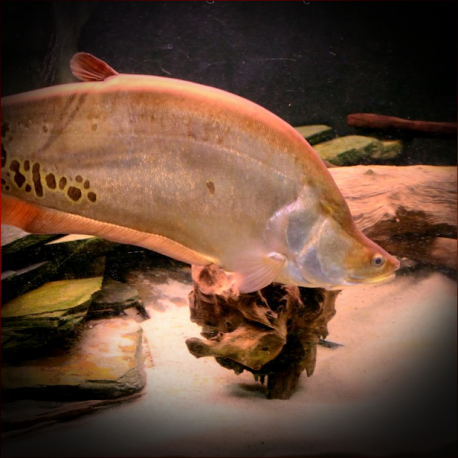More info
Datasheet
| Minimum Tank Size | 10000 litres / 2641.72 US gallons |
| Maximum Size | 122.0cm / 48.03inches |
| Temperature | 20°C / 68.00°F - 28°C / 82.40°F |
| Hardness | 2.02dgH / 36ppm - 15.02dgH / 268ppm |
| pH | 6.0-8.0 |
General Description
The Indian Featherback (Chitala chitala) belongs to the Osteoglossiformes order and is commonly misidentified in the aquarium trade. It can be distinguished by the presence of non-ocellated black spots in its posterior body and transverse gold or silver bars on its dorsum. Notopterids, including the Indian Featherback, have elongated anal fins, a humped appearance, small scales, and the ability to breathe air.
Aquarium Setup
The Indian Featherback requires a tank with dim lighting and refuges like driftwood, rocks, or plastic piping. A large, mature filtration system is essential, along with weekly water changes of 50-70% tank volume. Providing highly-oxygenated water with some movement is recommended. Water conditions include hardness of 36-268ppm, pH range of 6.0-8.0, and a temperature between 20-28 degrees Celsius (see table).
Behaviour
Peaceful with larger fish but territorial, especially with conspecifics or similar species in cramped spaces; Indian Featherbacks can exhibit such behavior.
Feeding and Diet
As obligate predators, Indian Featherbacks feed on smaller fish, crustaceans, and invertebrates in nature. In captivity, they adapt well to dead alternatives. Young fish can consume bloodworms, earthworms, and prawns, while adults accept fish flesh, shrimp, mussels, and more. Feeder fish and avian/meat-based foods should be avoided.
Reproduction & Dimorphism
Reproduction in captivity remains unreported, but in their natural habitat, female Indian Featherbacks deposit eggs on solid surfaces. Males guard and tend the eggs. Spawning occurs seasonally between May and August during the summer monsoon.
Habitat and Distribution
Most commonly found in major river channels and freshwater lakes, Indian Featherbacks have also been sighted in swamps and beels, particularly during spawning seasons. Their distribution is mainly restricted to the Indian subcontinent, including countries like Pakistan, India, Nepal, and Bangladesh. Previous records from Southeast Asia and Myanmar likely refer to other species within the genus Chitala.

